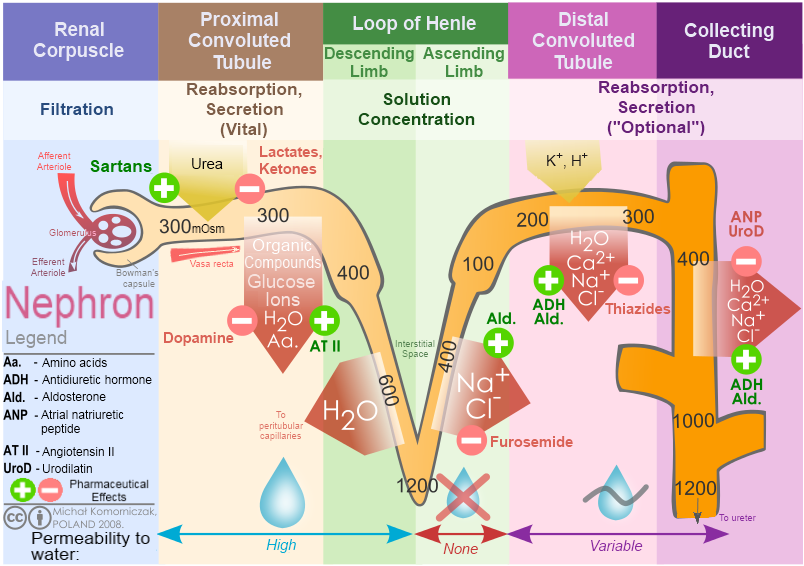Hypertension guideline in Taiwan
 |
| https://commons.wikimedia.org/wiki/File%3AKidney_nephron_molar_transport_diagram.png |
All of the information collected below is from 2015 Guidelines of the Taiwan Society of Cardiology and the Taiwan Hypertension Society for the Management of Hypertension
"We disagreed with the ESH/ESH joint hypertension guidelines suggestion to loosen BP targets to <140/90 mmHg for all patients."
"We strongly disagree with the suggestion by the 2014 JNC report to raise the BP target to <150/90 mmHg for patients between 60-80 years of age. "
1. For patients with diabetes, CHD, chronic kidney disease who have proteinuria, and those who are receiving antithrombotic therapy for stroke prevention, we propose BP targets of <130/80 mmHg in our guidelines.
2. BP targets are <140/90 mmHg for all other patient groups, except for patients 80 years of age in whom a BP target of <150/90 mmHg would be optimal.
3. Lifestyle change for HTN patients: S-ABCDE
S- Sodium restriction, low salt but not no salt, <2.0 gram/day may be harmful
A- Alcohol limitation
B- Body weight reduction
C- Cigarette smoke cessation
D- Diet adaptation
E- Exercise adoption
4. Drug therapy, consider PROCEED
P- Previous experience
R- Risk factors
O- Organ damage
C- Contraindications
E- Expert's or doctor's judgment
E- Expenses or cost
D- Delivery and compliance
5. Rule of 10 & Rule of 5
"With a standard dose of any one of the 5 major classes of anti-hypertensive agents, one can anticipate approximately a 10-mmHg decrease in systolic BP (SBP) (Rule of 10) and a 5-mmHg decrease in diastolic BP (DBP) (Rule of 5). [...], when 2 drugs with different mechanisms are to be taken together, the decrease in BP is the sum of the decrease of the individual agents (approximately 20 mmHg in SBP and 10 mmHg in DBP). "
"When doses of the same drug are doubled, there is only a 2-mmHg incremental decrease in SBP and a 1-mmHg incremental decrease in DBP."
6. Adjustment algorithm: AT GOALs
A- Adherence
T- Timing of administration
G- Greater doses
O- Other classes of drugs
A- Alternative combination or SPC(single pill combination)
L- LSM(life style modification) + Laboratory tests
7. Initiation of drug therapy
Condition: HTN stage 1, after 3 months of LSM but fail to reach the goal
Special cases: "[...]diuretics and beta-blockers should not be considered as first-line therapy in patients with metabolic syndrome or glucose intolerance, unless strongly indicated or used as an add-on therapy to reach target.
8. Timing of administration
"Morning administration of antihypertensive drugs was routinely performed in the past. However, it has been recently more common to switch to a bedtime administration.[...]The nighttime BP was more effectively decreased by bedtime administration of drugs. More importantly, asleep BP was the most significant predictor of event-free survival."
-- safe and effective choices: ACE inhibitors, ARB, or CCB
9. Goal
"[...]appropriate to control BP to targets at 3 months, and preferably within 1 month, for high-risk patients."
10. Thiazides
-- merits: ↓CHD, ↓heart failure, adding low dose-->effective when BP cannot be controlled with ACE inhibitors or ARBs, more effective on OB patients?
-- demerits: hypokalemia (not corrected with Triamterene), hyponatremia, metabolic effects
(A dose more than 25 mg/d of hydrochlorothiazide is considered to be a high dose and is associated with a significant increase in side effects including metabolic derangement.)
-- Chlorthalidone might be preferred compared to hydrochlorothiazide ???
11. Aldosterone antagonists
-- merits: beneficial for primary aldosteronism, resistant hypertension, prior CV events?(systolic, but no preserved ejection fraction)
"Treatment-resistant hypertension is defined in a recent review as high BP ( 140/90 mmHg), resistant to a treatment regimen that includes proper lifestyle modification plus a diuretic and two other antihypertensive agents of different classes at their optimal doses."
--demerits: hyperkalemia, rapid reduction of eGFR
12. Loop diuretics
-- merits: good for edema(+), CKD, CHF
-- demerits: not as effective in lowering BP
13. Other potassium sparing diuretics
-- demerits: not as effective in lowering BP
14. Beta-blockers
-- merits: good for CHD, MI, HR↑
-- demerits: increase stroke if pt's without CHD? Only in the elderly ( 60 years), atenolol was inferior to other drugs in reducing stroke? reduced sexual function, fatigue, reduced exercise capacity, and body weight increase, newly onset diabetes(with diuretics!) ; contraindication(both selelctive and non-selective)--> asthma
15. Calcium channel blockers
Dihydropyridine (DHP)
-- merits: ↓stroke,
-- demerits: less effective in ↓HF, peripheral edema,
Non-dihydropyridine (non-DHP)
-- demerits: less potent than DHP groups, more negatively chronotropic and inotropic, metabolized by CYP3A4
16. Angiotensin converting enzyme inhibitors
-- merits: pre-hypertension, preferentially indicated in patients with HF/diabetes/CKD
-- demerits: cough and angioedema
17. Angiotensin receptor blockers
-- merits: tolerability↑ discontinuation↓
-- demerits: should not be combined with ACE inhibitors (renal impairment)
18. Direct renin inhibitors (aliskiren)
-- safely combined with hydrochlorothiazide or amlodipine in the elderly (age 65 years) with stage 1 hypertension
-- demerits: hyperkalemia, hypotension and renal impairment if combined with ACEI or ARB
19. Other drugs(not first line)
-- alpha blockers(Doxazosin): treat resistant HTN/BPH
-- clonidine, alpha-methyldopa
-- hydralazine, minoxidil: cause fluid retention and tachycardia, hemolytic anemia, vasculitis, glomerulonephritis, and a lupus-like syndrome; (+)isosorbide dinitrate(Imdur)-->effective for African-American symptomatic HF
-- LCZ 696: dual-acting angiotensin receptor-neprilysin inhibitor (ARNI)
20. Combination
Early combination is suggested!
Preferred: A+C. A+D; B+C; R+C, R+D; A+C+D
Not recommended: B+D, A+R, A/R+DRI
***Recommendation***
1. Med Data Speaks
This is a website arranging data concerning oral antihypertensive drugs
https://meddataspeaks.wordpress.com/2015/11/29/%E8%87%A8%E5%BA%8A%E8%97%A5%E5%AD%B8-%E9%AB%98%E8%A1%80%E5%A3%93%E5%8F%A3%E6%9C%8D%E8%97%A5%E7%89%A9%E7%B8%BD%E6%95%B4%E7%90%86/
2. JNC 7(comorbidities and drug choice, not detailed):
https://s3.amazonaws.com/hcplive/n_media/image3/card-8-25-09.JPG
3. JNC 8(initial dose of drugs)
http://www.measureuppressuredown.com/HCProf/Find/BPs/JNC8/specialCommunication.pdf


沒有留言:
張貼留言